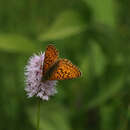North American Ecology (US and Canada)
provided by North American Butterfly Knowledge Network
Boloria eunomia is a resident across Canada and in several small populations through the US Rocky Mountain range (Scott 1986). Habitats are Canadian to alpine zone bogs and moist tundra. Host plants include shrub and herbaceous species from many families including Salicaceae, Polygonaceae and Violaceae. Eggs are laid on many plant species in clusters of 2-4, and rarely up to 20 eggs per clutch. Individuals overwinter as third and fourth instar larvae. There is one flight each year with the approximate flight time July 1- early Aug in the southern part of the range and June 15-July 31 in the north (Scott 1986).
Conservation Status
provided by University of Alberta Museums
Not of concern.
- license
- cc-by-nc
- copyright
- University of Alberta Museums
Cyclicity
provided by University of Alberta Museums
The single yearly flight peaks between early June and late August, depending on elevation.
- license
- cc-by-nc
- copyright
- University of Alberta Museums
Distribution
provided by University of Alberta Museums
A Holarctic species, found throughout the north-temperate region of the northern hemisphere. In North America, eunomia occurs from Alaska to Newfoundland, and south to Colorado in isolated Rocky Mountain populations (Scott 1986).
- license
- cc-by-nc
- copyright
- University of Alberta Museums
General Description
provided by University of Alberta Museums
"Best distinguished from look-alikes by characters of the hindwing underside: the only other Boloria with a dark-brick and silver-yellow underside is selene, but eunomia has a row of silvery submarginal spots, which are black in selene.
Three subspecies are part of the Alberta fauna, one resembling dawsonia throughout the boreal and foothills region, nichollae from the north-central mountains (described from the vicinity of the Columbia Icefields), and an undescribed subspecies from the Canadian Shield ecoregion of the far northeast (Bird et al. 1995)."
- license
- cc-by-nc
- copyright
- University of Alberta Museums
Habitat
provided by University of Alberta Museums
Bogs, fens, and moist alpine and subalpine meadows.
- license
- cc-by-nc
- copyright
- University of Alberta Museums
Life Cycle
provided by University of Alberta Museums
In Alberta, eggs hatch in 7 to 8 days, and larvae feed on the leaf underside of the host plant (Bird et al. 1995). Colorado and Wyoming larvae are reddish-brown with red spines, with third or fourth instars hibernating (Scott 1986). Adult males patrol to seek females (Scott 1986).
- license
- cc-by-nc
- copyright
- University of Alberta Museums
Trophic Strategy
provided by University of Alberta Museums
Larvae are reported to feed on willows (Salix spp.) in Alberta (Bird et al. 1995). Bistort (Polygonum viviparum) is also reported from western North America, in addition to heaths (Ericaceae) in western Canada (Layberry et al. 1998).
- license
- cc-by-nc
- copyright
- University of Alberta Museums

